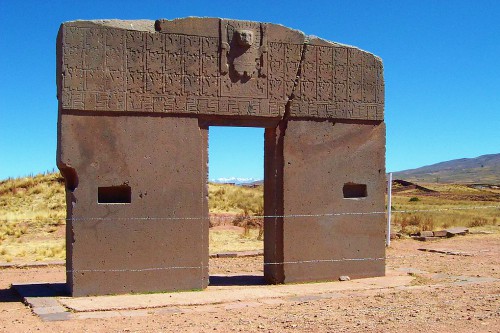|
Tiwanaku: Earth's Oldest Culture? Tiwanaku (Tiahuanaco) is an ancient civilization that existed on the Bolivian Altiplano (the Andes highlands) near present-day La Paz long before the Incas conquered and colonized the region. Although much about the Tiahuanacotas remains unknown, archeologists have uncovered sufficient evidence to believe that the Tiwanaku ruins found near Lake Titicaca are the remnants of an ancient city and ceremonial site that functioned as the capital city of the Tiahuanacota culture.
Because the indigenous groups that live in the highlands today claim this site as their own, many tourists believe Tiwanaku was an Incan, Aymara, or Quechua site; however, the Tiahuanacota culture, unrelated to them, actually inhabited this region and built this city hundreds, and possibly thousands, of years prior to their arrival. The Incas entered the region much later, conquering and assimilating other cultures. Because they mixed with the cultures they conquered, the Aymaras and Quechuas today refer to themselves as descendants of the Incas, although they were not originally Incan. The Tiahuanacota culture is thought to have disappeared quite abruptly around 1200 AD. The Incas claimed their god Viracocha had risen out of Lake Titicaca, created humankind, and built the city for them. According to the archeological evidence, however, that legend is untrue. Only a small percentage of the ruins have been uncovered and much still remains underground. Archeologists think that at its peak the city may have housed up to 50,000 people. A growing number of scientists believe that Tiahuanaco is as much as 17,000 years old, with some stating it may actually be one of the world's oldest cities, even older than Jericho. See more in these Tiwanaku videos and documentaries. The Tiahuanacotas were apparently very advanced in mathematics and astronomy; possibly more so than the Incas themselves. After the Spanish arrived in the early 1500’s, the ruins were looted and the treasures they contained were sent to Spain. The Catholic Church ordered many of the artifacts found to be destroyed as it considered them idols to pagan gods. Many of the stones were then used by the Spanish for construction. The few artifacts that remain are now housed in three Bolivian museums, at one on-site in Tiahuanaco and at two in La Paz. You can view some of these at the Museo Lítico Monumental (Museum of Stone Monuments) and at the Museo Nacional de Arqueología (National Archeology Museum) in La Paz, or you can take a Tiwanaku Tour offered by tour operators and hotels in La Paz and see the actual site itself. Learn more about TiwanakuTiwanaku tours sites and attractions How to get there and what to take Road maps and maps of the ruins Hotels, hostels and where to stay Tiwanaku photo and video gallery View our Tiwanaku travel forum How to get to Tiwanaku on your own Return to the Tiwanaku home page
    |
